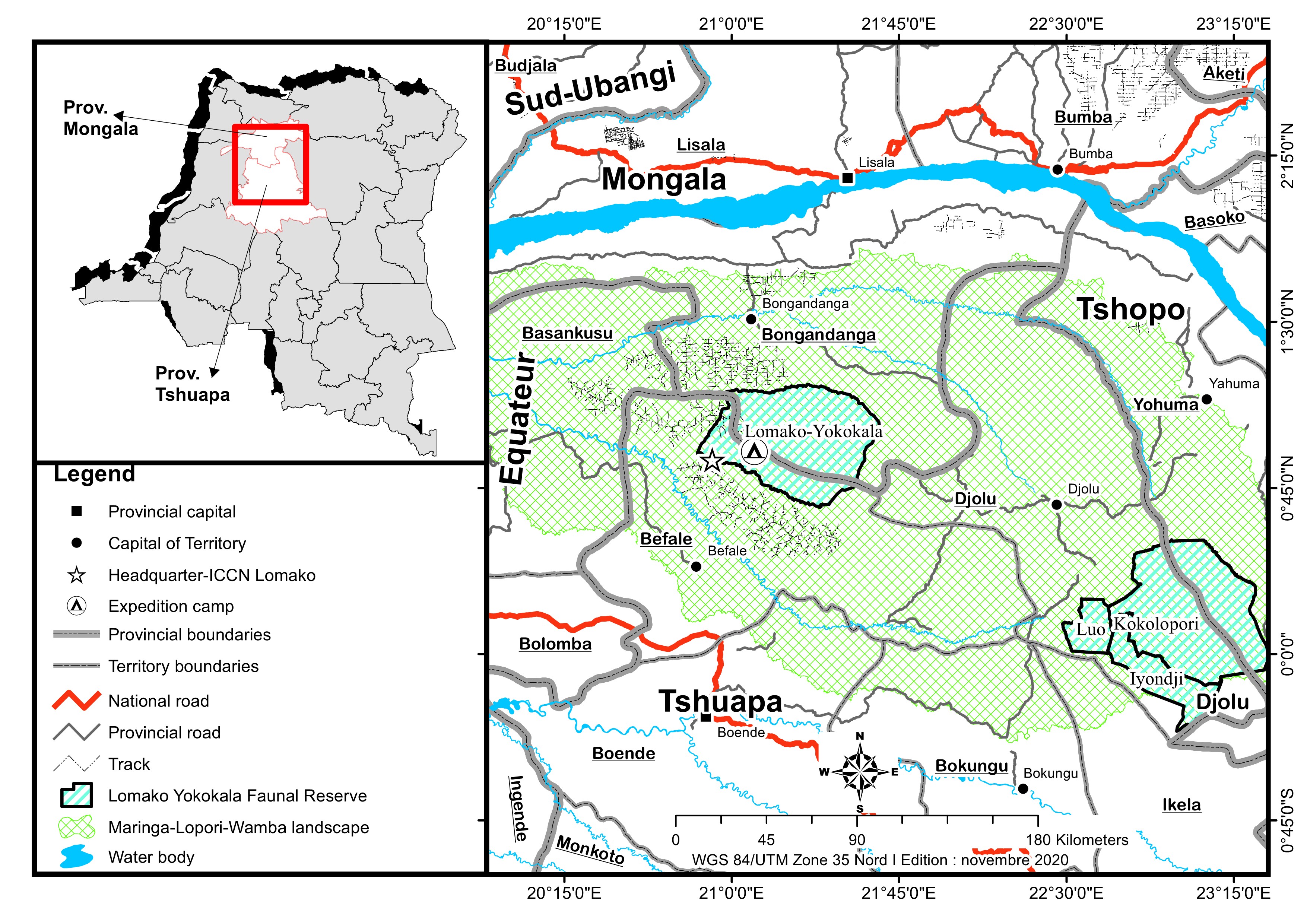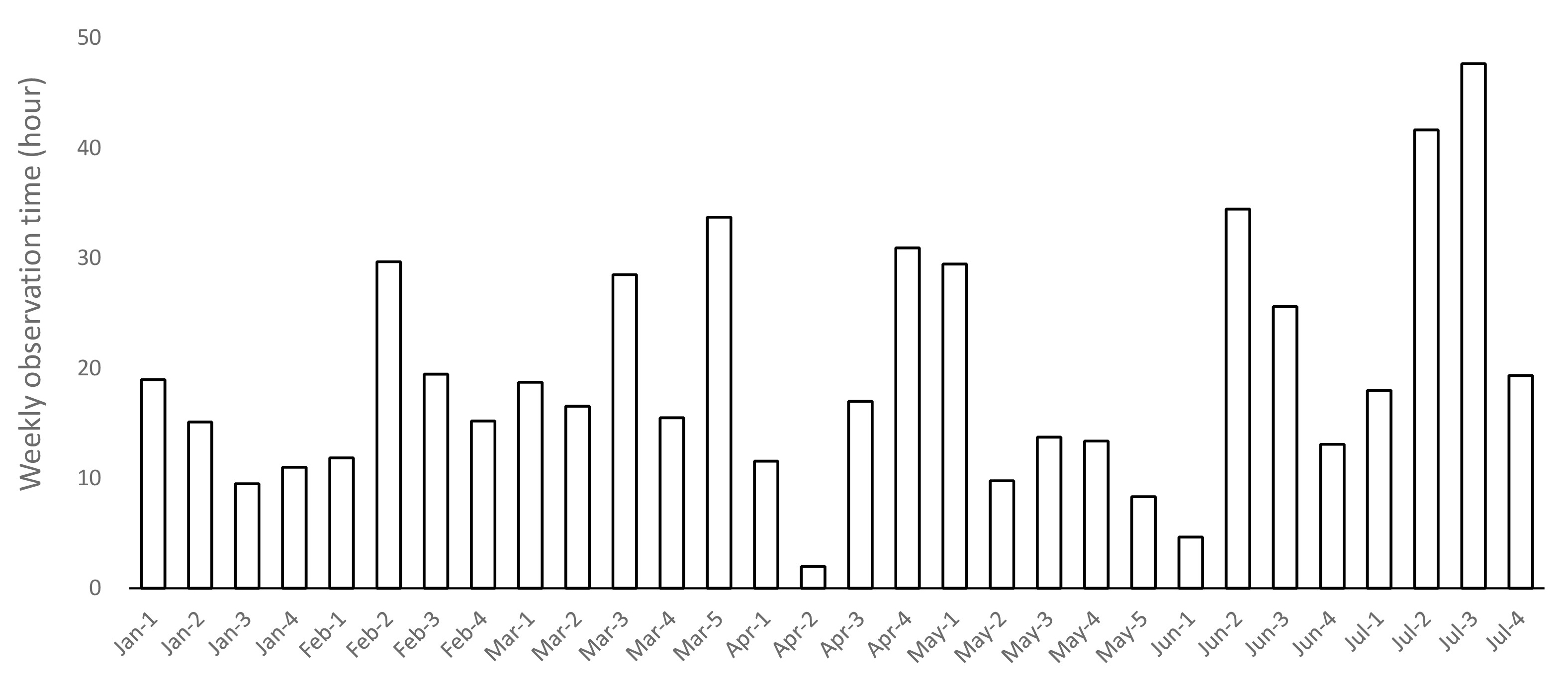|
<NOTE>
Published online (January 8, 2021)
Development of bonobo tourism in the Lomako Yokokala Faunal Reserve, the Democratic Republic of the Congo
Tetsuya Sakamaki 1,2
1 Antwerp Zoo Foundation, Royal Zoological Society of Antwerp, Belgium 2 Juristes pour le Renforcement et l´Application de la Loi dans le secteur de l´Environnement, the Democratic Republic of the Congo INTRODUCTION The bonobo (Pan paniscus) is an endangered endemic species (IUCN & ICCN 2012) in the Democratic Republic of the Congo (DRC). The main threats are deforestation, poaching, and disease transmission. The current population is estimated to be between 15,000 and 20,000 individuals as a minimum value (IUCN & ICCN 2012). Sustainable and viable management of protected areas (PAs) as strongholds of priority bonobo populations is crucial for bonobo conservation (IUCN & ICCN 2012). Currently, two national parks and six reserves are home to free-ranging bonobo populations. Most of these face a lack of financial and/or technical support needed for good management, putting the PAs at risk to become so-called ‘paper parks’ (Bruner et al. 2001). Apart from law enforcement by rangers, the presence of researchers and tourism activities is known to contribute to the conservation status of PAs (Pusey et al. 2007; Tranquilli et al. 2012). The presence of researchers and tourists, even if very limited and focused on a specialised niche, is not only a known deterrent for poachers but also a way to increase the visibility as well as awareness of the existence and importance of sometimes very remote and less well-known PAs. The Lomako Yokokala Faunal Reserve (RFLY) is one such location. Lomako forest has been known as a long-term study site of bonobos since 1974 (Badrian & Badrian 1977; White 1996), with teams from a number of universities and institutes (Stony Brook University, Max Planck Institute, Royal Zoological Society of Antwerp, Antwerp University, etc.) attempting to set up long-term research sites (Dupain & Van Elsacker 2001). In the 1980s, attempts were made to create a formally protected area in the Lomako forest, but the civil unrest and warfare in DRC in the 1990s interrupted the activities for bonobo study and conservation (Dupain & Van Elsacker 2001). Finally, in 2006, in the frame of the USAID-funded Central African Regional Program for Environment, the 3,625 km2 RFLY was officially gazetted (Figure 1).
*click image to enlarge
Figure 1. Map of Lomako Yokokala Faunal Reserve in the Democratic Republic of the Congo.
Since its creation in 2006, RFLY has been managed increasingly well by the Congolese Institute for the Conservation of Nature (ICCN). Due to performance-based management, with a focus on efficient law enforcement and community outreach, the RFLY is witnessing increasing numbers of fauna. Forest elephants are returning and bonobos are now ranging in places where they have not been observed for many years (Maptula et al. 2020; our personal observation). The Antwerp Zoo Foundation (AZF) of the Royal Zoological Society of Antwerp, together with a Congolese NGO, Juristes pour le Renforcement et l´Application de la Loi dans le secteur de l´Environnement (JURISTRALE), signed a memorandum of understanding with the DRC National Office of Tourism (ONT) and ICCN in 2019 and 2020, respectively, to prepare the Lomako for the tourism and scientific research that focus on bonobos. In this paper, we report the identification and habituation of bonobo communities. We discuss the potential for tourism development in RFLY and the involvement of local communities. HABITUATION OF BONOBOS Since the creation of the RFLY in 2006, intermittent efforts to habituate bonobos for tourism and scientific research continued until 2018. Representatives of the local communities have been involved in all stages of these efforts. The local communities are the traditional owners of the Lomako forest who agreed with the creation of the PA in 2006 and expressed their desire that the PA would bring improved livelihoods to their communities through bonobo-related employment. Permanent research camps in Lomako have played an important role in regular monitoring of bonobo populations and biodiversity. They have also provided various researchers with opportunities to conduct field studies and select tourists to visit bonobos. In agreement with the ICCN, the AZF/JURISTRALE took up the responsibility to ensure the continuation of the above-mentioned efforts and provided all financial as well as technical support to continue habituation and tourism development in mid-2019. A bonobo habituation expert (the first author, TS) improved the capacities of local assistants to follow bonobos from morning to evening. The assistants were also trained to recognise individual bonobos. Over the last year, the number of bonobos who accepted human observers at a distance of 10 m gradually increased. To date, we identified and named 21 individuals in one group: 10 females (6 adults, 2 subadults, and 2 infants) and 11 males (5 adults, 3 subadults, 2 juveniles, and 1 infant). Two or three adult males have not yet been individually recognised. This group is named ‘Tolende’ from the name of small tributaries in its ranging area, covering approximately 20 km2. We confirmed at least three neighbouring groups around the Tolende group. Most bonobos in the Tolende group are well habituated to the presence of observers, allowing for behavioural studies. In January–July 2020, monthly observation days and time were 23 days (median, range = 18–23 days; no surveys on weekends) and 84.1 hours (mean, range = 59.2–132.5 h), respectively. However, the observation conditions are still unstable. Figure 2 shows the weekly observation time of bonobos from January to July in 2020, indicating much fluctuation week by week. We typically followed bonobos continuously when they ranged in a relatively large party (10 individuals or more), while we frequently lost them and observation time was cut short when they split into several small parties.
*click image to enlarge
Figure 2. Fluctuation of weekly observation time of bonobos from January to July in 2020.
POTENTIAL FOR TOURISM The current progress of bonobo habituation, the existence of a permanent camp with trained assistants, and the history and reputation as a long-term study site are favourable indicators for attracting tourists and researchers to the Lomako forest. The good performance of the protected area authority, the ICCN, and the ongoing efforts for the best coordination between the ICCN and the tourism initiative create confidence for success. Further, the Lomako forest is not only attractive for its bonobos. Between January and July 2020, we recorded calls from Congo peafowls (Afropavo congensis) at our camp every 2.25 days. Birdquest, a British specialised-tour operator, successfully brought 6–8 clients to observe the Congo peafowls in Lomako on both endeavours in 2015 and 2017. Forest elephants (Loxodonta cyclotis) occasionally range in a part of the main study area. Four diurnal primates, black crested mangabey (Lophocebus aterrimus), red-tailed monkey (Cercopithecus ascanius), Wolf's monkey (C. wolfi), and Angola colobus (Colobus angolensis) daily visit the camp, and Allen's swamp monkey (Allenopithecus nigroviridis) are frequently observed along the Lomako River. Along with the river travel opportunities, travel agencies agree that there is an opportunity for a combination of packages for a variety of tourists. On the other hand, the remoteness of the Lomako forest and the lack of convenient access increase the cost and time needed for any visits. The bonobos in Lomako will never attract the same level of tourism and investment as the chimpanzees in Uganda and Tanzania or the mountain gorillas. However, this is not the intention either. Successful but albeit limited specialised niche tourism can improve the level of protection of the Lomako forest and its biodiversity. This can help avoid the RFLY becoming a forgotten park and a forgotten bonobo priority site. Well-chosen activities of tourism and research will improve the awareness of the existence of this important area for bonobo conservation and attract worldwide attention. This, in turn, also draws attention from Congolese governmental stakeholders (as is already the case). CONTRIBUTION TO LOCAL COMMUNITIES The development of specialised bonobo eco-tourism and scientific research is done in close collaboration with local communities. All local assistants and guides were selected from and appointed by these communities. At the yearly coordination meetings, representatives of the communities receive progress reports and discuss further plans. They also receive reports on the creation of income, if any, and their share. A general sense of ownership is embraced. Communities are proud to be visited by ‘the outside world’ even when limited. Not only the arrival of foreign researchers and tourists but also continued contact with former visitors through social media, for example, is highly appreciated. There is a general feeling that positive experiences by outside visitors can pull ‘Lomako’ out of its isolation and contribute to the well-being of the local community. This in return will improve the conservation status of this priority bonobo population. ACKNOWLEDGMENTS We are grateful to ICCN, Cosma Wilungula, Jeff Mapilanga, Elie Lubucibwa, Gentil Kisangani, RFLY rangers, Ministry of Tourism, Ministry of Scientific Research, Fanny Minesi of Les Amis des Bonobos, Alfred Simba, and the local communities of Lomako for their support and continuous assistance in various ways. In the field, we had help from Dipon Bomposo, Teddy Bofaso, Isaac Lokuli, Beken Bompoma, Gedeon Lokofo, Belvie Iyambe, Christian Dzambo, Aughu Lofili, Thomas Lokuli, and Mathieu Esaola. We are grateful to Alain Lushimba and Joël Masimo for the map of Lomako and to Takeshi Furuichi for useful comments. We thank the ARCUS foundation for its continuous support for the Lomako forest. REFERENCES Badrian A, Badrian N 1977. Pygmy chimpanzees. Oryx 14: 463–468. https://doi.org/10.1017/s0030605300014502 Bruner AG, Gullison RE, Rice RE, de Fonseca GAB 2001. Effectiveness of parks in protecting tropical biodiversity. Science 291: 125–128. https://doi.org/10.1126/science.291.5501.125 Dupain J, Van Elsacker L 2001. Status of the proposed Lomako Forest Bonobo Reserve: A case study of the bushmeat trade. In: All Apes Great and Small, Volume 1: African Apes. Galdikas BMF, Briggs NE, Sheeran LK, Shapiro GL, Goodall J (eds), Kluwer Academic/Plenum Publishers, New York, pp.259–273. https://doi.org/10.1007/0-306-47461-1_25 IUCN, ICCN 2012. Bonobo (Pan paniscus): Conservation Strategy 2012–2022. 2IUCN/SSC Primate Specialist Group & Institut Congolais pour la Conservation de la Nature, Gland, Switzerland. Maputla N, Lushimba A, Kasa P, Facheux C, Muruthi P 2020. First record of a breeding forest elephant herd in the Lomako Yokokala Faunal Reserve, Democratic Republic of Congo. Afr J Ecol 58:537–539. https://doi.org/10.1111/aje.12725 Krief S, Berny P, Gumisiriza F et al. 2017. Agricultural expansion as risk to endangered wildlife: Pesticide exposure in wild chimpanzees and baboons displaying facial dysplasia. Sci Total Environ 598:647-656. https://doi.org/10.1016/j.scitotenv.2017.04.113 Pusey AE, Pintea L, Wilson ML, Kamenya S, Goodall J 2007. The contribution of long-term research at Gombe National Park to chimpanzee conservation. Conserv Biol 21: 623–634. https://doi.org/10.1111/j.1523-1739.2007.00704.x Tranquilli S, Abedi-Lartey M, Amsini F, et al. 2012. Lack of conservation effort rapidly increases African great ape extinction risk. Conservation Letters 5: 48–55. https://doi.org/10.1111/j.1755-263X.2011.00211.x White FJ 1996. Pan paniscus 1973 to 1996: Twenty-three years of field research. Evolutionary Anthropology 5: 11–17. https://doi.org/10.1002/(SICI)1520-6505(1996)5:1%3C11::AID-EVAN5%3E3.0.CO;2-Z Received: 20 November 2020 Accepted: 21 December 2020 Back to Contents |

